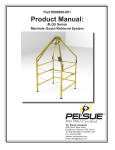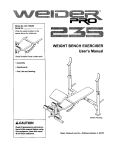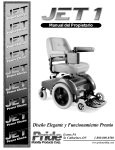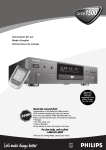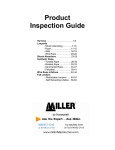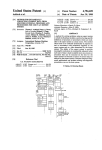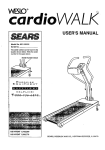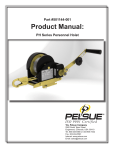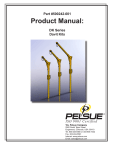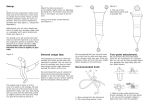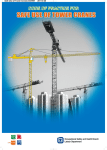Download Dynescape Manually Controlled Emergency Descent System
Transcript
ROSE MODEL NUMBER USER INSTRUCTIONS DYNESCAPE™ MANUALLY CONTROLLED EMERGENCY DESCENT SYSTEM ! WARNING National standards and state, provincial and federal laws require the user to be trained before using this product. Use this manual as part of a user safety training program that is appropriate for the user's occupation. These instructions must be provided to users before use of the product and retained for ready reference by the user. The user must read, and understand (or have explained), and heed all instructions, labels, markings and warnings supplied with this product and with those products intended for use in association with it. FAILURE TO DO SO MAY RESULT IN SERIOUS INJURY OR DEATH. 1.0 DESCRIPTION OF THE SYSTEM AND COMPONENTS The Dynescape Descender system is a controlled descent device designed for emergency rescue of an injured person from aloft, or emergency evacuation (self-rescue) by a person working at heights. The Dynescape is intended for use in conjunction with Rose anchorage connectors, connectors, body supports and other components to make up rescue/evacuation systems from elevations. When combined with other approved Rose components, the Dynescape may be used for vertical descent from virtually any structure, where suitable anchorage and no obstructions are present. THREE MODES OF VERTICAL EMERGENCY DESCENT ARE POSSIBLE: Mode 1: Self-rescue by a worker who lowers himself; Mode 2: Rescuer climbs down while lowering an injured person and guiding his descent; Mode 3: Rescuer remains aloft and lowers an injured person. All configurations of the system permit trained personnel to effect rescue or evacuation of up to a 310 lbs. (141 kg) working load with a 10:1 factor of safety, at an average controlled descent speed of 6.5’ (2 m) per second, over a maximum distance of 1501 (46 m). Copyright © 2000, Rose Manufacturing Company P/N 621883 Rev.E Page 2 USER INSTRUCTIONS ! DYNESCAPE MANUALLY CONTROLLED ! CAUTION Use the Dynescape descender only for emergency descent of one person at a time as described in this manual. DO NOT USE DESCENDER FOR FALL ARREST, WORK POSITIONING OR IN WAYS OTHER THAN SPECIFICALLY DESCRIBED IN THIS MANUAL. The basic Dynescape descender system consists of the Dynescape descent device, a length of 1/2 inch (13mm) polyester rope terminating in one thimble end and one spliced end (See Figure 1), two carabiner connectors (See Figure 2), and an anchorage connector strap (See Figure 3). These items are packed in a water resistant carrying bag (See Figure 4). The versatility of this system is greatly enhanced through use of a full body harness, such as the Rose Pullover Harness (See Figure 5). Optional equipment includes an Installation Snap Hook (See Figure 6). The Dynescape descender can be operated in one of the following three modes: MODE 1, SELF-RESCUE: The worker connects the thimble end of the rope to a suitable overhead anchorage using a carabiner (or other approved connector). The worker then connects the cam on the descent device with a carabiner to their approved body support. The free end of the rope is then dropped to the ground. The worker then takes up slack in the rope to suspend himself from the descender, and rotates the handle of the descender up to lower himself, controlling his rate of descent. See Figure 7. MODE 2, RESCUER DESCENDS: The rescuer connects the thimble end of the rope to a suitable overhead anchorage using a carabiner (or other approved connector). The rescuer then connects the cam on the descent device with a carabiner to the injured person’s approved body support. The free end of the rope is then dropped to the ground. The rescuer takes up slack in the rope to suspend the injured person from the descender, removes any equipment which might interfere with the rescue, and then alternately rotates the handle of the descender up to lower the injured person, and climbs down the structure, guiding the descent of the injured person. The rescuer must have an independent continuous fall protection system. See Figure 8. MODE 3, RESCUER REMAINS ALOFT: The rescuer connects the cam on the descent device with a carabiner to a suitable overhead anchorage. The rescuer then connects the thimble end of the rope to the injured person using a carabiner (or other approved connector). The free end of the rope is then dropped to the ground. The rescuer then takes up the slack to suspend the injured person from the descender device, disconnects any equipment which might impede descent of the injured person, and rotates the handle of the descender down to begin lowering and control the rate of descent. The rescuer must have an independent continuous fall protection system. See Figure 9. ! CAUTION: Use this system only for the types of rescue specifiaclly detailed in this manual. Do not attempt to use the system for any other application without first consulting the manufacturer. Failure to do so may result in serious personal injury or death. Other types of emergency descent using the Dynescape desender, such as angular descent of injured persons, and angular self-rescue from aloft, are possible with different combinations of components than those described in this manual. These applications require factory engineering P/N 621883 Rev.E Copyright © 2000, Rose Manufacturing Company USER INSTRUCTIONS ! DYNESCAPE MANUALLY CONTROLLED Page 3 assistance. Contact the Rose Sales Department for information on engineered descent systems. ! CAUTION Use of the Dynescape requires an anchorage connector connected to an overhead anchorage with a static tensile strength of at least 5,400 lbs., and suitable body support for the person being lowered., The anchorage connector and body support will vary depending on the intended application for the descender. Suitable anchorage connectors should be installed prior to beginning work at any location where the Dynescape might be required. Wherever possible, body supports such as full body harnesses should be worn during the normal course of work. These measures will save valuable time during a rescue, This al contains several suggested anchorage connectors. Consult the manufacturer for additional anchorage connection means for specific applications. 1.1 DYNESCAPE DESCENDER The Dynescape descender assembly consists of a central sheave protected by an aluminum housing; two internal spring-loaded pawls; two rope roller guides; a moving cam; a handle; an external rope guide; and a length of 1/2 inch (13 mm) three strand twisted polyester rope with one free end (spliced so the rope may not be removed from the descender) and one metal teardrop thimble end. See Figure 1. The rope is reeved between one roller guide and the cam, around the central sheave, and between the other roller guide and the cam. The thimble end of the rope is used for attachment to an approved anchorage connector (Modes 1 and 2) or body support (Mode 3). When the descender is connected to an anchorage connector or body support and the rope is then loaded, the cam pinches against the rope on the side leading to the free end of the rope and prevents it from sliding through the descender. Therefore, the descender handle is always rotated towards the rope thimble to disengage the cam from the rope and begin descent. The descender permits the rescuer to control the rate of descent by varying the rotation of the descender handle. Greater rotation of the handle toward the rope thimble decreases the friction between the cam and the rope and increases the rate of descent; lesser rotation increases the friction and thus decreases the rate of descent. The descender incorporates a “dead man’s” feature, and will automatically stop on the line when the handle is released* The spring-loaded pawls interact with the housing to prevent the pulley from rotating in the direction of the thimble end of the rope. The pulley will only rotate in the direction of the free end of the rope, permitting a user to pull on this end to take up slack between the descender and the thimble end of the rope. ! CAUTION The rope is specifically sized for the sheave and selected for compatibility with the system. Do not attempt to remove or replace the rope. The external rope guide is permanently attached to the housing. It ensures that the rope enters the descender at the correct angle, and also helps control the speed of descent. Copyright ©2000, Rose Manufacturing Company P/N 621883 Rev.E Page 4 USER INSTRUCTIONS ! DYNESCAPE MANUALLY CONTROLLED FIGURE 1: Dynescape Descender P/N 506416 ! CAUTION The position of the rope guide is factory set. Do not alter the position of the rope guide. Multiple rescues are possible in all modes of use by pulling the rope back through the device from the free end. 1.2 CARABINER Two lightweight aluminum carabiners are provided with the system. The carabiners interfacebetween the anchorage connector and descender, and between the descender and body support. The connection point varies depending on which mode of rescue is to be used. The carabiner will normally be compatible with all descender-body support connections. . Depending on the anchorage connector being used, the carabiner may not be a compatible connector between anchorage connector and descender. ! CAUTION If any question as to the suitability of the carabiner as a compatible connector exists, consult the manufacturer for assistance in selecting a compatible connection means. P/N 621883 Rev.E Copyright © 2000, Rose Manufacturing Company USER INSTRUCTIONS ! DYNESCAPE MANUALLY CONTROLLED Page 5 The carabiner incorporates a positive locking- mechanism, which requirestwo separate and distinct manipulations by the user to open and unlock the snaphook gate. When the carabiner gate is released it will close and lock automatically. See Figure 2. FIGURE 2 Carabiner P/N 506259 ! CAUTION Always check to be sure gate is closed and locked. TO OPEN: TO CLOSE: 1. Rotate outer gate (A) 90o 1. Release gate and it will close (C) and lock (D) 2. Depress gate to open (B) 1.3 * NOTE: Lubricate area about hinge and inner sleeve (on both sides of snap). ANCHORAGE CONNECTOR STRAP The anchorage connector strap is a highly versatile installation linkage. See Figure 3. It consists of a length of 3”, (76 mm) wide nylon webbing, with a minimum tensile strength of 5,400 lbs (24 kN). The anchorage connector strap has a sewn loop at one end, and a D-ring at the other end. It may be looped around structural members such as beams with a minimum edge radius of 1/32”, (0.8 mm). The D-ring end is then passed through the sewn loop and the strap cinched down. The thimble end of the rope (Modes 1 and 2) or descender cam (Mode 3) is then connected to the D-ring using one of the carabiner connectors. 1.4 CARRYING BAG The carrying bag is a lightweight, vinyl coated nylon bag with draw string and nylon carrying handles. See Figure 4. The carrying bag is sized to permit packaging of a complete system for rescue and evacuation, including the components described above and a separately purchased body support. Copyright ©2000, Rose Manufacturing Company P/N 621883 Rev.E Page 6 USER INSTRUCTIONS ! DYNESCAPE MANUALLY CONTROLLED FIGURE 3: Anchorage Connector Strap P/N 505282 FIGURE 4: Carrying Bag P/N 622080 P/N 621883 Rev.E Copyright © 2000, Rose Manufacturing Company USER INSTRUCTIONS ! DYNESCAPE MANUALLY CONTROLLED Page 7 1.5 OPTIONAL COMPONENTS ! CAUTION Under no circumstances should products of other manufacturers be used in conjunction with Rose products or systems without the prior written consent of Rose Manufacturing Company. Use of incompatible products of other manufacturers may result in serious personal injury or death and damage to equipment. 1.5.1 BODY SUPPORTS The versatility of the Dynescape descender system is greatly enhanced through use of a full body harness such as the Rose Pullover Harness. Pullover Harnesses are available in various models, with different combinations of D-rings. The models recommended by the manufacturer for controlled descent applications incorporate a sternal (chest) D-ring. See Figure 5. If a Pullover harness with sternal D-ring is the body support, the rescuer may attach the cam (Modes 1 & 2) or descender rope (Mode 3) directly to the sternal D-ring, take up slack, and commence lowering. All Pullover harnesses permit adjustment of the harness for different sizes by means of one overall torso adjustment buckle. A sub-pelvic strap permits the user to attain a seated position during lowering. The harness straps are color coded to aid in donning. Depending on model selected, the harnesses incorporate D-rings in various locations. The dorsal (back) D-ring is provided for attachment of fall arrest lifelines. The sternal (chest) D-ring is used during lifting/lowering and rescue/evacuation. Shoulder D-rings may be provided for attachment of a “V” or “Y” retrieval lanyard (with or without spreader bar) for lifting, lowering and positioning. Hip D-rings may be provided to obtain additional versatility. They permit tie-off with a suitable lanyard for work positioning only. Pullover harnesses are made with 1-3/4 inch nylon or polyester webbing, with a minimum tensile strength of 6,800 lbs. (30 kN). Nylon is recommended for neutral or alkaline environments; polyester is recommended for acidic environments. The harnesses come with either single pass friction buckle or tongue buckle thigh straps. Literature describing the range of Rose harnesses is available from the manufacturer. 1.5.2 INSTALLATION SNAPHOOK The installation snaphook is a versatile piece of installation hardware as it can often be used without any special adaptation of the anchorage. See Figure 6. The snaphook is a self-closing, self-locking connector which requires two separate and distinct manipulations to unlock and open the gate, yet may be manipulated using only one hand. To open, the spring-loaded gate is rotated 90 degrees around its axis and then depressed along its hinge axis. To close and lock, the gate is released. The installation snaphook has a minimum tensile strength of 5,400 pounds (24 kN) and a throat opening of 2" (51 mm). It is constructed from formed steel, zinc chromate plated ‘to resist corrosion. ! CAUTION Install the installation snaphook so that unwanted movement of the snap during lowering is prevented. Otherwise, movement of the load may cause sudden movement of the snaphook and result in loss of balance by the operator. The installation snaphook may not be used in Mode 3 rescue to attach the cam directly to the anchorage. Copyright ©2000, Rose Manufacturing Company P/N 621883 Rev.E Page 8 USER INSTRUCTIONS ! DYNESCAPE MANUALLY CONTROLLED FIGURE 6: Installation Snaphook P/N 506308 ! CAUTION Always check to be sure gate is closed and locked. TO OPEN: 1. Rotate outer gate (A) 90o 2. Depress gate to open (B) TO CLOSE: 1. Release gate and it will close (C) and lock (D) FIGURE 5: Pullover Harness P/N 502733 P/N 621883 Rev.E Copyright © 2000, Rose Manufacturing Company USER INSTRUCTIONS ! DYNESCAPE MANUALLY CONTROLLED Page 9 Contact Rose Manufacturing Company for information on other optional accessories, such as harness comfort pads, back supports, and spreader bar assemblies. 2.0 USER TRAINING All users of the emergency descent system must be thoroughly trained in all aspects of installation, inspection, use and maintenance as described in this manual. However, the instructions contained in this manual cannot and must not take the place of hands-on training under the supervision of a competent person. ! WARNING THE MANUFACTURER REQUIRES THAT ALL USERS OFTHE SYSTEM RECEIVE HANDS-ON TRAINING IN ALL ASPECTS OF INSTALLATION, INSPECTION, USE AND MAINTENANCE UNDER THE SUPERVISION OF A QUALIFIED PERSON. TRAINING SHOULD BE PERFORNED UNDER CONTROLLED CONDITIONS WHICH APPROXIM M LIKELY WORK CONDITIONS AND WHICH PROVIDE BACKUP SAFETY FOR TRAINERS AND TRAINERS. REQUEST SEPARATE INSTRUCTIONS FROM ROSE MANUFACTURING FOR SUCH A TRAINING PROGRAM. If the system is to be used under adverse weather conditions, particular attention should be focused on: 1. The restricted mobility due to bulky clothing; 2. The decrease in endurance due to cold weather conditions; 3. Environmental hazards that. may affect rescue/evacuation procedures. A RESCUE PLAN MUST BE ESTABLISHED PRIOR TO BEGINNING WORK AT A SITE WHERE USE OF THE SYSTEM MAY BE REQUIRED. The rescue plan must take into account environmental and site specific factors which may affect the ability of rescuers to perform their roles effectively. Standby rescue personnel should be available and emergency preparedness training should cover the steps to be taken to summon trained rescue personnel and the actions to be performed while awaiting their arrival. Each member of the work crew should be prepared to assume the duties of any other member should an emergency situation arise. Training should include the procedures to be followed by all crew members in case of an emergency and the appropriate first aid procedures to assist an injured person. Each member of the work crew should wear the necessary protective equipment at all times during use of the system. Such protective equipment should include appropriate clothing, protective headgear and personal fall protection equipment. Provision should be made for transportation of an injured person to a site which can provide appropriate medical attention. Copyright ©2000, Rose Manufacturing Company P/N 621883 Rev.E Page 10 USER INSTRUCTIONS ! DYNESCAPE MANUALLY CONTROLLED ! CAUTION Node 2 descent (rescuer descending with injured person) affords greater control of the injured person during descent but will substantially lengthen the time required to effect a rescue. Rescuers must be trained to evaluate the condition of an injured person and decide instantly which method of rescue is indicated. 3.0 INSPECTION AND MAINTENANCE Before beginning work at any site, first inspect the descender system in accordance with the instructions in this section. Look for excessive wear, damage, alteration, missing parts, corrosion and foreign matter that may impair proper function. Make sure that all components are packed in the order in which they will be needed. NOTE: The descender system must be formally inspected by a competent person semi-annually. Inspections should be logged, records preserved and made available for examination upon request. An inspection log is provided in Appendix B, and an inspection grid is located on the label near the rope thimble end, for this purpose. 3.1 INSPECTION OF DESCENDER Perform the following inspections and refer to Figure 1 for identification of parts. Check the descender for loose or missing bolts and nuts. Check for presence of the rope guide. Remove from use and return to the manufacturer if any of these parts are missing. Check that the cam moves freely between the rope on either side. Check that the roller guides rotate freely and are not excessively worn. Check that the rope will slide through the descender at a controlled rate when the cam is disengaged from the rope. Check that the central sheave moves easily in the direction of the free rope end. A clicking sound indicates that the internal pawls are operating correctly. Check that the sheave does not rotate in the opposite direction (toward the rope thimble end). Remove from use and return to Rose manufacturing Company if the clicking sound is not heard, or if the sheave rotates in both directions. Check for excessive corrosion and remove from use if evident. Check the entire length of the rope for burns, cuts, abrasion or fraying which could impair its strength. Check for hockling (unlaying) of the twisted rope. If any of these conditions are found, remove the descender from use and return it to the manufacturer. ! CAUTION The rope used with the descender is specifically selected for compatibility with the descender. No substitution or repair of this rope is possible and must not be attempted. The free rope end is terminated so that it may not be removed from the descender. Remove the system from use if any evidence exists that the rope has been altered or replaced and immediately return it to the manufacturer. P/N 621883 Rev.E Copyright © 2000, Rose Manufacturing Company USER INSTRUCTIONS ! DYNESCAPE MANUALLY CONTROLLED Page 11 Check that the rope thimble is secure. Check for the presence of the hog ring that retains the spliced ends. Check that the labels attached to the thimble end and free end are present and legible. If any of these items are missing or illegible, remove the descender from use and return to the manufacturer. The descender requires no lubrication. Store the descender in the carrying bag in a clean, dry place out of sunlight and where it cannot come into contact with corrosives. 3.2 INSPECTION OF THE CARABINERS Check the operation of each carabiner. It should close and lock automatically when released. Check to make sure that the spring fully closes the rotating lock. If any defect is found, remove the carabiner from use and replace it with one which passes inspection. Check that the carabiner label is present and legible. If not, remove from use until a new label is obtained and in place. Check that one carabiner is attached to the rope thimble and the other attached to the descender cam. NOTE: If necessary, lubricate the area about the hinge and inner sleeve (on both sides of the snap) using a silicone based lubricant such as WD-40. ! CAUTION Gate should not open under pressure from any direction unless intentionally unlocked. If this condition is not met or if any steps A, B, C, or D described in Section 4.0 cannot be performed properly, remove carabiner from use. 3.3 INSPECTION OF ANCHORAGE CONNECTOR STRAP Check the anchorage connector strap for damaged stitching, worn threads, burns, cuts, abrasions or fraying of web which could impair strength. Check the D-ring for cracks,, bends, nicks, deformation and corrosion. If any of these conditions is found, immediately remove the anchorage connector strap from use, and replace it with another anchorage connector strap which passes inspection. Store the anchorage connector strap in a cool, dry place. Do not store the anchorage connector strap in direct sunlight for prolonged Periods . The ultraviolet rays of the sun can cause degradation of the webbing. Clean the anchorage connector strap using warm water and a mild detergent suitable for washing clothing. Do not use harsh detergents, Harsh detergents will damage the webbing and impair the strength of the anchorage connector strap. Hang the anchorage connector strap to dry in a dry place indoors. 3.4 INSPECTION OF CARRYING BAG Store the carrying bag in a cool, dry place. Do not store the carrying bag in direct sunlight for prolonged periods. The ultraviolet rays of the sun can cause degradation of the bag material. The interior of the carrying bag should be kept clean and dry. Clean the carrying bag using warm water and a mild detergent suitable for washing clothing. Do not use harsh detergents. Harsh detergents will damage the material. Hang the carrying bag to dry in a dry place indoors. Copyright ©2000, Rose Manufacturing Company P/N 621883 Rev.E Page 12 USER INSTRUCTIONS ! DYNESCAPE MANUALLY CONTROLLED Re-package descender system in carrying bag after inspection as follows; Step l: Rope coiled into bottom of bag; Step 2: Descender laid on top of coiled rope; Step 3: Anchorage strap folded, and laid on top of descender. 3.5 INSPECTION OF OPTIONAL COMPONENTS 3.5.1 INSPECTION OF PULLOVER HARNESS Check the harness for altered, missing or damaged parts. If any of these conditions is found, immediately remove the harness from use, and replace it with another harness, which passes inspection. Store the harness in a cool, dry place. Do not store the harness in direct sunlight for prolonged periods. The ultraviolet rays of the sun can cause degradation of the harness webbing. Clean the harness using warm water and a mild detergent suitable for washing clothing. Do not use harsh detergents. Harsh detergents will damage the webbing and impair the strength of the harness. Hang the harness to dry in a dry place indoors. If other components, such as the installation snaphook are part of the descent system, inspect each of these components according to the instructions which accompanied that product. 4.0 USE OF THE DYNESCAPE DESCENDER SYSTEM 4.1 WORKPLACE ANALYSIS Before beginning normal work operations at a site where the Dynescape is to be used, it is extremely important to carefully analyze factors in the work place, which may affect the use of the descender and related equipment. These factors include work place geometry environmental factors; the location and nature of work hazards; location and strength of the anchorages on which the Dynescape anchorage connector will be placed; and the work space of the person(s) to be connected to the system. Other factors may exist which cannot be foreseen by the manufacturer but will become evident to the competent or qualified person at the work place who makes or supervises the installation. Take enough time to consider all foreseeable possibilities. Evaluate the expected vertical travel of a load during rescue to identify areas of danger. THE DESCENDER LINE MUST BE ABLE TO EASILY EXTEND DOWNWARD TO THE LOWEST EXPECTED WORK ELEVATIONE THE LINE SHOULD NOT CONTACT SHARP EDGES OR PASS TOO CLOSE TO OBJECTS WHERE IT CAN BECOME LODGED, BURNED OR CUT. Never plan a rescue path close to an electrical hazard. Once the descender system has been thoroughly checked in accordance with the instructions in Section 3.0 it will remain unused during the normal course of work at a site. If emergency rescue of one or more persons is required, first summon additional rescue personnel to stand by at ground level. FOLLOW THE EMPLOYER’S RESCUE PLAN. THE EMERGENCY PLAN MUST IDENTIFY SUITABLE ANCHORAGES TO BE USED DURING THE RESCUE AND APPROVED ANCHORAGE CONNECTORS. NOTE: Rose Manufacturing Company is able to provide assistance with hazard analysis, rescue procedure design and training, and design, manufacture and installation of anchorage connectors and engineered rescue systems. P/N 621883 Rev.E Copyright © 2000, Rose Manufacturing Company USER INSTRUCTIONS ! DYNESCAPE MANUALLY CONTROLLED 4.2 MODE 1: Page 13 SELF-RESCUE (EVACUATION) The equipment required for self rescue or evacuation is: 1. Descender system; 2. Rose Pullover Harness with sternal (chest) D-ring or other body support approved by Rose; 3. Appropriate personal protective equipment (hard hat, gloves, etc.). Perform the following steps in sequence for self rescue or, evacuation. 4.2.1 Attach the selected anchorage connector to an overhead anchorage. NOTE: The Dynescape descender is shipped from the factory with approximately 61 (1.8m) of rope terminated with the thimble extending above the descent device to facilitate connection to the anchorage connector or body support. If more rope is needed to effect the connections, it must be fed through the device from the free end. It is not possible to pull on the thimble end to obtain additional rope. See Figure 10. 4.2.2 Connect the rope thimble to the anchorage connector using the carabiner or other connector supplied. To unlock and open the carabiner gate perform the following steps and refer to Figure 20 Step 1: Step 2: Rotate gate 90 degrees about its axis (unlock). Depress gate until it pivots about hinge (open). To close and lock the gate* Step 3: Release gate and it should swing back and contact the nose (close). Step 4: The gate should then rotate 90 degrees and engage the nose (lock). 4.2.3 Drop the free end of the rope to the surf ace from which evacuation. MAKE SURE THE ROPE EXTENDS FREELY DOWN TO THE EVACUATION AREA AND IS NOT KNOTTED OR KINKED. 4.2.4 Use the remaining carabiner to connect the descender cam to the chest D-ring of the Pullover Harness, or to another designated attachment point, depending on the body support being used. See Figure 7. 4.2.5 Pull on the free end of the rope to take up slack between the descender and thimble end of the rope, until suspended from the descender rope. Copyright ©2000, Rose Manufacturing Company P/N 621883 Rev.E Page 14 USER INSTRUCTIONS ! DYNESCAPE MANUALLY CONTROLLED FIGURE 7: Mode 1: Self-Rescue/Evacuation 4.2.6 Rotate the handle of the descender in the direction of the rope thimble end to begin descent . The direction is up for Mode 1 rescue (self-rescue or evacuation). Move the handle in the opposite direction to slow and stop the descent. TWO hands are normally required to control the descender. ! CAUTION To eliminate sudden movement of descender, maintain a firm grip on the descender handle when transferring weight to the descent system, and transfer weight gradually. Emergency descent of more than one person is possible using the descender system. The next P/N 621883 Rev.E Copyright © 2000, Rose Manufacturing Company USER INSTRUCTIONS ! DYNESCAPE MANUALLY CONTROLLED Page 15 person aloft retrieves the descender by pulling the rope up, then pulls the rope back through the device from the free end, and lowers the free end back down to ground level. The next person is then connected to the system and lowering effected according to the instructions above. ! CAUTION Once the Dynescape descender has been used in a rescue or evacuation, it must be immediately removed from service and returned to the manufacturer for inspection and service. 4.3 MODE 2: RESCUE OF AN INJURED PERSON, RESCUER DESCENDS The equipment required for rescue is: l. Descender systems; 2. Rose Pullover Harness with sternal (chest) D-ring or other body support approved by Rose; 3. Appropriate personal protective equipment (hard hat, gloves, etc.). 4. Personal fall arrest equipment to be used by the rescuer. Perform the following steps in sequence to rescue the person from aloft. 4.3.1 Attach the selected anchorage connector to an overhead anchorage. NOTE: The Dynescape descender is shipped from the factory with approximately 61 (1.8m) of rope terminated with the thimble extending above the descent device to facilitate connection to the anchorage connector or body support. If more rope is needed to effect the connections, it must be fed through the device from the free end. It is not possible to pull on the thimble end to obtain additional rope. See Figure 10. 4.3.2 Connect the rope thimble to the anchorage connector using the carabiner or other connector supplied. See Figure 8. To unlock and open the carabiner gate, perform the following and refer to Figure 2: Step 1: Rotate gate 90 degrees about its axis (unlock). Step 2: Depress gate until it pivots about hinge (open). To close and lock the gate Step 1: Release gate and it should swing back and contact the nose (close). Step 2: The gate should then rotate 90 degrees and engage the nose (lock). 4.3.3 Drop the free end of the rope to the surface from which evacuation to medical facilities will be effected. MAKE SURE THE ROPE EXTENDS FREELY DOWN TO THE EVACUATION AREA AND IS NOT KNOTTED OR KINKED. Copyright ©2000, Rose Manufacturing Company P/N 621883 Rev.E Page 16 USER INSTRUCTIONS ! DYNESCAPE MANUALLY CONTROLLED 4.3.4 Use the remaining carabiner to connect the descender cam to the chest D-ring of the injured personts Pullover Harness, or to another designated attachment point, depending on the body support or rescue support being used. See Figure 8. ! CAUTION Take care to move the injured person as little as possible during rescue. Make sure that no part of the injured Persons body or equipment is dangling in a way that presents a snag hazard, which might prevent lowering. 4.3.5 Pull on the free end of the rope to take up slack between the descender and thimble end of the rope, so that the injured person is suspended from the descender rope. FIGURE 8: Mode 2: Emergency Rescue, Rescuer Descends P/N 621883 Rev.E Copyright © 2000, Rose Manufacturing Company USER INSTRUCTIONS ! DYNESCAPE MANUALLY CONTROLLED Page 17 4.3.6 If the injured person is suspended from equipment used for positioning or fall protection, disconnect that equipment. ! CAUTION Be careful not to drop surplus equipment to the surface below, to avoid injury to surface level rescuers. If it is necessary to cut any equipment off the injured person, be careful not to cut the descender rope. 4.3.7 Rotate the handle of the descender in the direction of the rope thimble end to begin descent of the injured person. This direction is up for Mode 2 rescue (rescuer descending with injured person). Move the handle in the opposite direction to slow and stop the descent. ! CAUTION To eliminate sudden movement of the descender, maintain a firm grip on the descender handle when transferring weight to the descent system, and transfer weight gradually. 4.3.8 The rescuer must alternately climb down and then lower the injured person to guide their descent. This requires that the rescuer climb down so the descender is within reach above his head, and then operate the descender so it slides down the rope to approximately waist level. The rescuer then climbs down so the descender is again above head height, and repeats the sequence. The rescuer must have separate continuous fall protection. ! CAUTION Mode 2 descent affords greater control of the injured person during descent than Mode 3, but will substantially lengthen the time required to effect a rescue. Rescuers must be trained to evaluate the extent of injury to an injured person and decide instantly while aloft which method of rescue is indicated. Emergency descent of more than one person is possible using the descender system. To effect multiple descents for Mode 2, the rescuer pulls the descender up while climbing aloft. The rescuer then pulls the rope back through the device from the free end and lowers the free end back down to ground level. The next injured person is then connected to the system and lowering effected according to the instructions above. ! CAUTION The rescuer in no case is to attempt descent using the descender while the injured person is connected to the descender. Attempting to do so may result in serious injury or death. Once all rescues have been accomplished, the rescuer may attach himself to the descender and descend to ground level, by following instructions for Mode 1, self-rescue/evacuation. Copyright ©2000, Rose Manufacturing Company P/N 621883 Rev.E Page 18 USER INSTRUCTIONS ! DYNESCAPE MANUALLY CONTROLLED ! CAUTION Once the Dynescape descender has been used in a rescue or evacuation, it must be immediately removed from service and returned to the manufacturer for inspection and service. 4.4 MODE 3: RESCUE OF AN INJURED PERSON, RESCUER REMAINS ALOFT The equipment required for rescue is: l. Descender system; 2. Rose Pullover Harness with sternal (chest) D-ring or other body support approved by Rose; 3. Appropriate personal protective equipment (hard hat, gloves, etc.); 4. Personal fall arrest equipment to be used by the rescuer. Perform the following steps in sequence to rescue the person from aloft. 4.4.1 Attach the selected anchorage connector to an overhead anchorage. NOTE: The Dynescape descender is shipped from the factory with approximately 61 (1.8m) of rope terminated with the thimble extending above the descent device to facilitate connection to the anchorage connector or body support. If more rope is needed to effect the connections, it must be fed through the device from the free end. It is not possible to pull on the thimble end to obtain additional rope. See Figure 10. 4.4.2 Connect the descender cam to the anchorage connector using the carabiner attached to the cam. To unlock and open the carabiner gate: Step 1: Rotate gate 90 degrees about its axis (unlock). Step 2: Depress gate until it pivots about hinge (open). To close and lock the gate: Step 1: Release gate and it should swing back and contact the nose (close). Step 2: The gate should then rotate 90 degrees and engage the nose (lock). 4.4.3 Drop the free end of the rope to the surface from which evacuation to medical facilities will be effected. MAKE SURE THE ROPE EXTENDS FREELY DOWN TO THE EVACUATION AREA AND IS NOT KNOTTED OR KINKED. 4.4.4 Use the remaining carabiner to connect the rope thimble to the chest D-ring of the injured person’s Pullover Harness, or to another designated attachment point, depending on the body support or rescue support being used. See Figure 9. P/N 621883 Rev.E Copyright © 2000, Rose Manufacturing Company USER INSTRUCTIONS ! DYNESCAPE MANUALLY CONTROLLED ! Page 19 CAUTION Take care to move the injured person as little as possible during rescue. Make sure that no part of the injured person’s body or equipment is dangling in a way which presents a snag hazard which will prevent lowering. 4.4.5 Pull on the free end of the rope to take up slack between the descender and thimble end of the rope, so that the injured person is suspended from the descender rope. FIGURE 9: Mode 3: Emergency Rescue, Rescuer Remains Aloft Copyright ©2000, Rose Manufacturing Company P/N 621883 Rev.E Page 20 USER INSTRUCTIONS ! DYNESCAPE MANUALLY CONTROLLED 4.4.6 If the injured person is suspended from equipment used for positioning or fall protection, disconnect that equipment. ! CAUTION Be careful not to drop surplus equipment to the surface below, to avoid injury to surface level rescuers. If it is necessary to cut any equipment off the injured person, be careful not to cut the descender rope. 4.4.7 Rotate the handle of the descender in the direction of the rope thimble end to begin descent of the injured person. The direction is down for Mode 3 rescue (rescuer remains aloft). Move the handle in the opposite direction to slow and stop the descent. Two hands are normally required to control the descender. ! CAUTION To eliminate sudden movement of descender, maintain a firm grip on the Descender handle when transferring weight to the descent system, and transfer weight gradually. Emergency descent of more than one person is possible using the descender system. To effect multiple descents for Mode 3 rescue,, the rescuer retrieves the thimble end of the rope by pulling the rope back through the device from the free end and lowers the free end back down to ground level. The next injured person is then connected to the system and lowering effected according to the instructions above. ! CAUTION The rescuer in no case is to attempt descent using the descender while the injured person is connected to the descender. Attempting to do so may result in serious injury or death. Once all rescues have been accomplished, the rescuer may attach himself to the descender and descend to ground level, by following instructions for Mode 1, self rescue/evacuation. ! CAUTION Once the Dynescape descender has been used in a rescue or evacuation, it must be immediately removed from service and returned to the manufacturer for inspection and service. P/N 621883 Rev.E Copyright © 2000, Rose Manufacturing Company USER INSTRUCTIONS ! DYNESCAPE MANUALLY CONTROLLED Page 21 FIGURE 10: Back-Threading the Dynescape Lifeline To thread the rope back through the device, start with the free end of the rope and work the rope in the direction of the arrows, as shown. Back thread short sections of rope at a time, until the thimble end of the rope is the desired length. 5.0 SERVICE AND SPARE PARTS Except as described in Section 3. 0, Inspection and Maintenance, the Dynescape descender system has no user serviceable parts The factory is the only authorized service location. Replacement components and service may be obtained by contacting. ROSE MANUFACTURING COMPANY 2250 SOUTH TEJON STREET ENGLEWOOD, COLORADO 80110-1041 PHONEE. (303) 922-6246 TOLL FREE*. (800) 722-1231 FAX*. (303) 934-9960 Replacement components will only be shipped as complete assemblies. Copyright ©2000, Rose Manufacturing Company P/N 621883 Rev.E Page 22 USER INSTRUCTIONS ! DYNESCAPE MANUALLY CONTROLLED 5.1 ORDERING SERVICE AND REPLACEMENT PARTS When ordering spares, follow the directions below. 5.1.1 Identify the part number of the component to be replaced. 5.1.2 Contact the manufacturer at the address and phone number listed above to order the replacement component. The following information is required when ordering: a) Part number and description of component to be replaced; b) Contact person for the manufacturer in case additional information is required; c) Contact person address and telephone number; d) Name of person ordering the replacement component; e) Shipping address for the replacement component; f) Purchase order authorizing the manufacturer to furnish the replacement component. Please note that all descenders returned to the factory must, at a minimum, be disassembled, cleaned and inspected before re-assembly. Therefore a service charge will apply for all systems and/or components returned to the factory. Upon receipt of an order, the manufacturer will supply a return shipping date. If inquiring about an order that has already been placed, be prepared to provide the information listed above, as applicable, and the date on which the order was placed. The manufacturer will provide estimated packaging and shipping costs to permit calculation of the total purchase order amount required. Shipments are made FOB Englewood, Colorado, USA. Freight charges are normally prepaid and added to the invoice unless other arrangements are made in advance. 6.0 LABELS AND MARKINGS 6.1 The following labels must be present, legible and securely attached to the Dynescape Manually Controlled Descender. The Formal Inspection Grid must be punched with a date (month/year) within the last six months. If not, remove the Dynescape Manually Controlled Descender from use and mark it as “UNUSABLE” until a Formal Inspection is performed. CARRYING BAG LABEL P/N 621883 Rev.E Copyright © 2000, Rose Manufacturing Company USER INSTRUCTIONS ! DYNESCAPE MANUALLY CONTROLLED Page 23 MODEL IDENTIFICATION LABEL ATTACHED TO CARRYING BAG ROPE FREE END LABEL IDENTIFICATION LABEL WARNING LABEL INSPECTION GRID LIFELINE IDENTIFICATION LABEL THIMBLE END LABEL Copyright ©2000, Rose Manufacturing Company P/N 621883 Rev.E Page 24 USER INSTRUCTIONS ! DYNESCAPE MANUALLY CONTROLLED DYNESCAPE DESCENDER LABELS P/N 621883 Rev.E Copyright © 2000, Rose Manufacturing Company Rose Part No.: Date of Mfg.: Date of Inspection Inspector Dynescape Descender Bolts and Nuts Rope Guide Cam Roller Guides Rope Movement USER INSTRUCTIONS ! DYNESCAPE MANUALLY CONTROLLED Serial No.: 7.0 DYNESCAPE SYSTEM INSPECTION Copyright ©2000, Rose Manufacturing Company 7.1 DYNESCAPE SYSTEM INSPECTION LOG Sheave Rotation Internal Pawls Corrosion Labels Page 25 P/N 621883 Rev.E Continued on Back of Page Page 26 P/N 621883 Rev.E Continued from Front of Page Lifeline Rope Wear/Damage Hockling Rope Thimble Splices Labels Labels Strap Webbing Wear/Damage D-Ring Copyright © 2000, Rose Manufacturing Company Bag Environment Clean/Dry Interior Out of Sunlight Note: For a complete description of inspection criteria, refer to User Manual, Section 3.0. USER INSTRUCTIONS ! DYNESCAPE MANUALLY CONTROLLED Carabiners Operational Check Attachments USER INSTRUCTIONS ! DYNESCAPE MANUALLY CONTROLLED Page 27 DYNESCAPE™ MANUALLY CONTROLLED EMERGENCY DESCENT SYSTEM OWNER REGISTRATION IMPORTANT: Fill out this form at the time of purchase. A duplicate is provided with each new unit which must be filled out and returned to Rose Manufacturing Company. If ownership changes, the new owner must contact Rose Manufacturing Company to re-register the unit. Serial Number: Model Number: OWNER: Name: Permanent Address: Telephone: Dynescape Manually Controlled Emergency Descent System Custodian and Title: PURCHASED FROM: Name: Address: DATE OF PURCHASE: Month Day Copyright ©2000, Rose Manufacturing Company Year P/N 621883 Rev.E Page 28 USER INSTRUCTIONS ! DYNESCAPE MANUALLY CONTROLLED WARRANTY Express Warranty – Rose/MSA warrants that the product furnished is free from mechanical defects or faulty workmanship for a period of one (1) year from first use or eighteen (18) months from date of shipment, whichever occurs first, provided it is maintained and used in accordance with Rose/MSA’s instructions and/or recommendations. Replacement parts and repairs are warranted for ninety (90) days from the date of repair of the product or sale of the replacement part, whichever occurs first. Rose/MSA shall be released from all obligations under this warranty in the event repairs or modifications are made by persons other than its own authorized service personnel or if the warranty claim results from misuse of the product. No agent, employee or representative of Rose/MSA may bind Rose/MSA to any affirmation, representation or modification of the warranty concerning the goods sold under this contract. Rose/MSA makes no warranty concerning components or accessories not manufactured by Rose/MSA, but will pass on to the Purchaser all warranties of manufacturers of such components. THIS WARRANTY IS IN LIEU OF ALL OTHER WARRANTIES, EXPRESS, IMPLIED OR STATUTORY, AND IS STRICTLY LIMITED TO THE TERMS HEREOF. ROSE/MSA SPECIFICALLY DISCLAIMS ANY WARRANTY OF MERCHANTABILITY OR FITNESS FOR A PARTICULAR PURPOSE. For additional information please contact the Customer Service Department at 1-800-MSA-2222 (1-800-672-2222). ROSE MANUFACTURING COMPANY ! 2250 SOUTH TEJON STREET ENGLEWOOD ! COLORADO ! 80110-1000 ! USA TEL. (303) 922-6246 ! TOLL FREE (800) 722-1231 ! FAX (303) 934-9960 Dynescape™ Descender and Pullover™ Harness are trademarks, rights to which are held by Rose Manufacturing Company, U.S.A. Protected by the following U.S. patents: 4,589,523; 4,434,536; 5,361,867. Foreign patents issued and applied for. P/N 621883 Rev.E Copyright © 2000, Rose Manufacturing Company





























